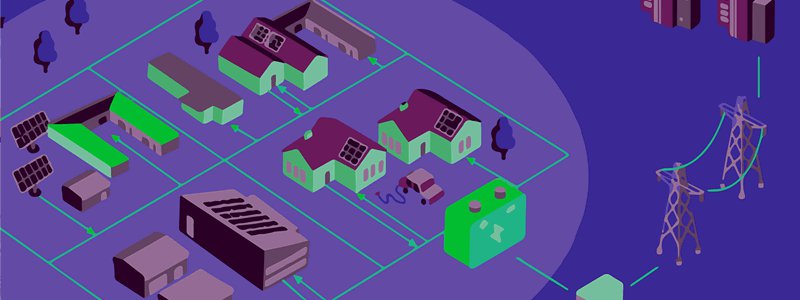
Why microgrids?
Conventional power grids provide reliable power - most of the time that is. Traditionally, energy grids have mainly been centralized, meaning that energy generation happens at one central point. Through the use of transmission and distribution lines, that energy is then delivered to the end customers. However, with the recent surge of renewable energy projects, driven by accelerated cost reductions, centralized energy production is becoming less and less attractive.
In Europe, traditional energy grids are having trouble dealing with all of the new renewable energy capacity that is being installed. Most growing solar energy markets still struggle to find grid connections for photovoltaic (PV) projects in time, often causing major delays for project developers. Another challenge with renewable energy sources is their inherent intermittency, which has proven to be a major barrier when integrating various types of energy sources on the same system. To cope with, and circumvent, these grid connection and intermittency issues, companies and utilities are working together to build robust, flexible power systems called microgrids.
What kind of solutions do microgrids offer?
A microgrid is designed to provide uninterrupted power and can balance load demands for a company or organization with changing power needs. It can operate either as part of the traditional grid or independently (or both). Since microgrids are not dependant on the traditional grid, their stability in challenging situations (eg. heavy weather and power outages) offers enhanced resiliency for communities and businesses. Microgrids also allow for power to be generated locally, rather than transmitted from one central utility source, therefore making it easier to keep it safe from physical and cyber threats. Also, sophisticated software can allow operators to optimize power usage based on demand, utility prices, and other factors.
What are the business cases for microgrids?
Microgrid Platform
As the prices of solar panels and wind turbines keep decreasing, more and more business cases for microgrids are emerging, and fast. “I want you to walk away with the conclusion that positive business cases for microgrids are already here,” said Wouter Vermeiden, Manager Business Development at ZOWN, during a webinar on grid-connected microgrids last week. ZOWN, an energy initiative from Energy Exchange Enablers (EXE), develops several types of microgrids, which help to integrate different forms of renewables. Amongst others, they offer microgrid platforms that use a combination of both PV & wind; microgrids that can be linked directly to the energy market; and microgrids that can connect solar PV directly onto a local AC or DC installation, like a factory or stadium. Connecting a microgrid directly to a local demand source allows for some significant benefits, including 50% lower investment costs (compared to network connection), lower transportation costs and a shorter installation period.

ZOWN’s microgrid platform (Image credits: ZOWN)
Local Energy System
Some residential communities in rural areas have already opted to adopt microgrids as part of their energy supply. E.ON, a Swedish energy provider, has been developing a positive business case for microgrids in which they offer a local energy system (LES) that can run 100% on renewables.
One of their projects, located in southern Sweden, has around 150 connection points and 200 customers (mostly residential), with a peak load of around 800 kW and an annual consumption of 2,1 GWh/year. The microgrid used for this residential community gets its energy from a 400 kW PV array and a 500 kW wind turbine generator. To balance the generated energy and the demand load, E.ON added an 800 kW battery storage system to the microgrid in order to cope with the intermittent power supply of PV and wind. Since the microgrid is also meant to be able to be operated off-grid, E.ON also added a backup generator - fueled by hydrated vegetable oil (HVO) - to compensate for the size of the battery and to be able to keep the microgrid running for 48 hours at peak load without energy contributions from PV or wind. The entire microgrid is run using a smart control and energy management system, which is responsible for controlling the PV array, wind turbine, battery, and backup generator, and is also responsible for synchronizing and going off-grid, when needed.

(image credits: E.On)
Microgrid as an Upgrade
Another microgrid initiative worth highlighting is Duke Energy’s idea of replacing a 50-year-old coal-fired power plant in North Carolina, USA with a solar+storage microgrid. Duke Energy, an American utility company, stated that its primary motivation for building the microgrid project in the mountainous town of Hot Springs, North Carolina was to enhance the resiliency and reliability of the energy grid, as the town is being powered by a 10-mile, 22.86-kV feeder line that incurs frequent blackouts. Repairing this feeder line in the Great Smoky Mountains would require expensive equipment upgrades. This, together with the lack of right-of-way options, has led Duke Energy to choose for installing a microgrid as a better, cheaper and cleaner solution.

(Image source; Duke Energy)
The Hot Springs microgrid project will operate using 2 MW of solar and 4 MW lithium-based battery storage facility. The storage system will allow the microgrid to “island-disconnect” from the main grid during power outages and use the energy stored in the battery to meet up to 90 percent of the town’s peak load for four to six hours. This innovative idea represents a change in thinking of traditional utilities on how they can provide alternative forms of energy to their customers.
Grid-connected microgrids have been used in the US in the past, but predominantly to deal with resiliency issues. However, the current costs of renewable energy technologies are now globally at a point where microgrids are becoming a cost-effective solution for transmission and distribution companies that are considering making upgrades to their systems. This has led to various microgrids projects popping-up in Europe, such as ZOWN’s microgrid and E.ON’s LES.
